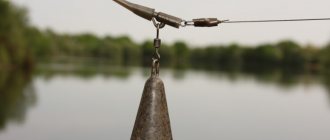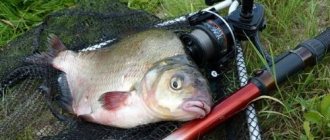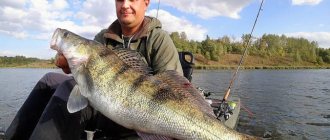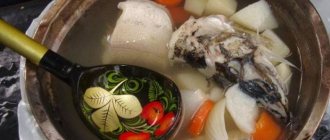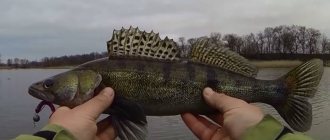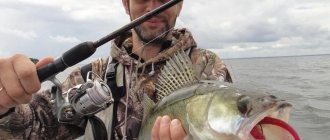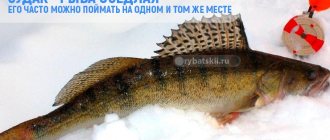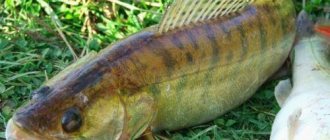Fishing with live bait
Are you planning to catch pike perch with live bait, but don’t know what hook to use to catch it? No problem! The site catcher.fish will tell you which hook is used to catch pike perch using a float rod, a jig or other live bait tackle.
There are no special requirements for selecting a hook for pike perch, but still, there are some points that are important to know and that will make your catching of a predator better.
All the information can be contained in literally a couple of paragraphs, so it won’t take much of your time.
So, if we talk about catching pike perch with live bait, then a single hook, a double hook or a treble hook can be used. Each of them has its pros and cons, and must also have certain characteristics. Let's look at everything in order.
Methods for securing live bait
It is very important to know how to properly place live bait on a hook when hunting for pike perch, or any other predator, and what type of equipment your hook should have. This determines how long it will be active, which is necessary to attract fish.
You need to know that hooks for live bait when hunting for pike perch have one feature, regardless of whether it is a single hook, a double or even a tee, it must be very sharp, of high quality and, which is typical for them, it must be as thinner _ Such a hook does not injure the fry as much, which means it allows it to remain mobile longer.
There are several options for how to put live bait on a hook when hunting for pike perch:
- The simplest one is that the tip of the hook is carefully threaded through the back of the fry. This way it is securely fixed, but it is damaged quite badly and does not remain active for so long.
- A leash with a hook is passed through the gills. With this method, the fry is slightly damaged and remains mobile for a long time. This is good, in this case your equipped equipment for catching pike perch with live bait may remain without your attention until the fish bites.
- Using two hooks. One is carried through the gills, and the other is attached to the back or near the tail.
- A complex but effective method - the tail part of the fry is tied with thread and the hook is attached to it. The fish is not damaged at all and can attract predatory fish for a long time.
In addition to these methods, you can simply hook the bait on the lip, as if you had just caught it, but this method is usually used during active biting, when the angler does not have time for cunning fasteners.
Single hook for zander
A single hook has the main advantage over a double or treble hook, which is that it is the least noticeable; when used, the predator is not afraid to attack live bait.
Also, due to the fact that a single hook has only one sting, if a pike perch pricks itself on it, it will only be when it has already gotten a good hook.
In general, a single hook is good because pike perch bites on it are always the most confident.
A single hook also has disadvantages, because it only has one sting, and this sometimes leads to the fact that the predator does not sit securely enough on the hook or attacks the fish from the wrong side on which the hook sting is located.
A single hook can be used when catching pike perch using mugs or girders, and for vertical fishing it is best to use a jig head with live bait attached to it.
The optimal jig head size for catching pike perch is No. 2/0, 3/0. Take a regular single hook from No. 1-4 according to the European classification. Choose hooks with a long shank, they are much more convenient and practical.
Hook for pike perch: which hook to choose when fishing with live bait, number
09/23/2017 by Evgeny Timonin in the Sudak section Number of people who read the article: 3,671
Are you planning to catch pike perch with live bait, but don’t know what hook to use to catch it? No problem! The website rybkolov.ru will tell you which hook is used to catch pike perch using a float rod, a girder or other live bait gear.
There are no special requirements for selecting a hook for pike perch, but still, there are some points that are important to know and that will make your catching of a predator better. All the information can be contained in literally a couple of paragraphs, so it won’t take much of your time.
So, if we talk about catching pike perch with live bait, then a single hook, a double hook or a treble hook can be used. Each of them has its pros and cons, and must also have certain characteristics. Let's look at everything in order.
How to properly attach live bait using different methods
Fishing with live bait has always been characterized by increased chances of catching large specimens of pike, perch, pike perch, asp, burbot, catfish and other predators. At the same time, these are, as a rule, passive fishing methods.
The term live bait is more applicable to small fish used as bait. But this definition also includes any nimble fish, that is, larger live bait. For example, gudgeon, loach, bleak, ruff and others.
Experienced fishermen have many secrets of such fishing . I would like to share with beginners some of the most important ones.
How to choose hooks for live bait
Regarding the choice of hooks among experienced fishermen, of course, there is no consensus. Everyone comes from their own experience in this matter, and it is acquired over time and depends on many factors and ingenuity.
To develop some rules, you will have to engage in analytical practice. Which, however, will only please any avid fisherman. And the main tips can be boiled down to the following recommendations .
- For very small baitfish, twin hooks should be used (not to be confused with double hooks!). Such hooks are mounted as follows. A small thin hook is soldered to the forend of the main, stronger one. The latter is where live bait is attached.
- You can use a short leash (up to 10 centimeters long). In this case, hooks with a long shank (Owner, Gamakatsu) are used as the main ones, and a thin small hook for bait is attached to the leash.
- The size of the hooks directly depends on the size of the fish for bait. Numbers from 12 to 6 are used.
- It is preferable to catch large aquatic predators with forged hooks (double or treble hooks). Experienced fishermen claim that with tees there are fewer accidents.
- The size of the hook is selected taking into account the type of fish that is going to be caught.
- Live bait is attached exclusively to a thin and small hook .
On a note. Russian-made hooks are quite unpredictable. Sometimes they are overheated and break at the most inopportune moment.
We have also put together a short video guide from which you will learn even more about the rules for choosing hooks for live bait.
What kind of bait are they using to catch what?
It is known that large predatory fish feed on small fish. This means that the length of live bait should not exceed 7-9 centimeters . And it should also be narrow-bodied (like a loach or goby).
Note: for catfish, the size and shape of the bait are indifferent.
- The loach is used for catching catfish and perch.
- Pike perch, asp, perch, and chub go well for minnows.
- Ruff is a fairly tenacious bait. Can live on a hook for several days. Used for catching pike in winter.
- Gobies will be required when fishing in reservoirs where very few of them live. Pike perch and pike perch are happy to take this bait.
- Asp and chub are caught on one-year-old perch. Pike also loves this bait.
- In ponds overgrown with dense thickets, small crucian carp attract pike. This is a very tenacious bait .
- Pike also like roach as a nimble and tenacious fish.
- Minnow is good for ponds with slow currents. Pike and large perch are caught here with it.
- Bleak is used in warm water. The bait is nimble, but quickly dies on the hook. You have to change the bait often. This fish is used to catch most aquatic predators.
- Spinning bait is suitable for catching predatory fish of a wide variety of species and is considered by many anglers to be the best bait.
- Verkhovka (verkhovka) is a good bait for pike perch and pike perch. The asp suits her best.
Important! Fry of valuable fish should not be used as bait. For example, bream, catfish, pike perch and others. And in Western Europe, fishing with live bait is generally prohibited. Here they fish with canned fish, available in four sizes (4, 6, 8 and 9 cm).
How to properly place live bait on a hook
The float is indispensable when fishing from the shore in heavily overgrown reservoirs. It can also be used when fishing from a boat. A strong and long fishing rod is used (up to 4-6 meters) with a spinning reel, which can be high-speed or ordinary, with an average gear ratio.
It is convenient to catch pike perch with such tackle. Fishing takes place with a leash. For pikes it should be steel.
To attach live bait you will need a single or double (triple) hook. On a single fish, the fish is placed behind a nostril or two lips. A double or triple is passed under the upper fin on the back.
The bait used for fishing with live bait is distinguished by the presence of a removable leash. For pike it should be steel.
The leash is connected to a clasp and a swivel. It is attached twenty centimeters above the sinker. For pike fishing, it is better to secure the leash at a distance of one and a half to three meters. The leader is passed through the mouth and gills of the bait.
It is not recommended to use bleak and verkhovka for this method of fishing, which fall asleep almost immediately.
However, they can be secured to the back by inserting a hook under the dorsal fin, thereby extending the period of activity. In this case, you will have to throw the tackle very carefully.
You can fish both in winter and in autumn or spring (in calm water and a depth of up to two meters). If you equip the bait with an additional foam float, the bait will be closer to the surface - increasing the chances of catching a pike or perch.
In this case, you should decide who it is betting on and choose the appropriate tactics. Bottom placement of the gear will allow you to catch burbot.
In the water column, the line is effective for catching asp, catfish, perch and pike. But the line for catching catfish must be strong and reliable. Live baits are attached to both lips at once for reliability.
If you are going to fish in a pond with snags, it is better to use fry. They won't be able to get under the snags. It is preferable to use this tackle on narrow bodies of water.
The leashes are attached at meter intervals. The length of each is up to 60 centimeters. The main line is 0.6 millimeters. And for leashes 0.3-0.4 millimeters in diameter is suitable.
The use of a boat is justified during the autumn cooling period , when the fish begin to eat. Many fishermen love this fishing method. It puts you in a peaceful mood.
If there is no current, you can use three fishing rods at once (both sides and stern). When moving and on bodies of water with current, two fishing rods are used, attached to the sides of the boat.
Fishing takes place in places with shallower depths. The live bait is located forty centimeters from the bottom. In windy weather or in places with current, it is permissible to use wiring, when the tackle is adjusted by releasing the line from the reel.
Rod length up to 4.5 meters. The reel is taken to be a spinning reel with a capacity of up to 100 m of fishing line (0.20 millimeters). The leash must be used with a swivel to avoid twisting.
During the current, the bait is secured through the upper lip or by threading a leash through the mouth and gills.
In calm water, you can thread the hook through the back under the fin. Hooks are used single, double, special triple.
In addition to the popular methods mentioned, fishermen successfully use it for live bait fishing:
- “elastic band” – near reeds and on stretches (throws without jerking!);
- zherlitsa - on small rivers and near the banks (a willow rod is used as a fishing rod);
- mugs - on closed reservoirs (they are a so-called floating girder, disks made of wood or polypropylene). Read more about fishing with mugs here.
Basic mistakes when fishing with live bait
- Incorrect selection of live bait (the predator did not like the bait).
- Wrong choice of method for attaching live bait for a specific fishing method and equipment that we use in this case.
- Rare change of live bait . The bait dies and the fish lose interest in it. However, it is worth noting that among fishermen there are many supporters of fishing for dead fish. It is considered a good winter bait.
- Fastening with a single hook behind the back (the bait breaks off).
- Previously, pulling out the tackle prevented the pike from chewing the bait (the predatory fish first tries to kill and turn over the fry and only then swallows the bait!).
On a note.
Some fishermen put a rubber band on the fry's tail and thread a hook through it.
As a result, unharmed bait lives a long time. But this fishing method is not suitable for fishing for pike - predators bite the gum and leave.
hook attachment examples
Below is an example of four ways to attach live bait for fishing on a girder. All the subtleties of mounting on a single hook (using a safety hook) and a double are considered. And also for a pike leash with a safety hook (double and tee). The “humane” method, in which the baitfish does not die, is also interesting.
Source: https://ribakmak.ru/kryuchok-na-sudaka-kakoj-kryuchek-vybrat-pri-lovle-na-zhivtsa-nomer.html
Double for zander
A double hook for catching pike perch will be the golden mean, which is located between a neat single hook and a so-so harsh tee, which practically does not forgive the predator’s mistakes.
A double hook does not cause any particular danger to the fish, like a tee, and, at the same time, a double hook is more reliable than a single hook in terms of the quality of hooking fish.
Single bites or fish leaving a double hook happen less frequently than with a single hook, since the double hook has a higher chance of successfully hooking the fish when biting.
For catching pike perch, choose double hooks No. 1-4, as well as single hooks. It’s also better to choose doubles with a long fore-end - it’s easier to put on live bait, and it will be easier to pull the double out of the pike perch’s mouth later.
There are doubles for catching pike perch, in which one hook is smaller than the other. The smaller hook is used to attach live bait, and due to the fact that this hook is smaller and thinner, live bait receives less injury when hooked and remains active longer.
Spinning or donka
In the spring, pike perch, hungry over the winter, rushes at everything that moves. This is the best time for spinning fishing. Donks are ineffective at this time. Then the fanged predator begins spawning, after which it rests for 10-15 days: fishing at this time is useless.
But after resting, the fish becomes active again and starts hunting. In spring it is better to use small and light baits. The length of the rod must be at least 3 m, and the thickness of the fishing line - 0.15-0.2 mm.
Summer time is also suitable for spinning fishing. At this time, it is better to use a wobbler or spinner that goes 0.5-2 m deep: with their help it is easy to “feel” moderate temperature layers in order to search for schools of pike perch.
For bait, it is best to use a jig with a foam head or a retractable leash with a twister bait.
In autumn, the water temperature drops and pike perch dives to a depth of 5 m and below. During this period, dull baits with a narrow cross-section and wobblers with deep depth should be used for fishing.
At this time, it is better to use bottom tackle for pike perch - a feeder. This is an active bottom method of fishing, in which first, complementary feeding is carried out at selected points in the water area, and then bottom equipment is placed in these places. It includes:
- feeder rod;
- feeder equipment consisting of a leash, a hook and a feeding weight;
- non-stretch braided line;
- spinning reel.
The advantages of this fishing method include:
- the possibility of spot fishing at a great distance from the shore;
- increased chances of success, because at depth the fish feels safe and is more willing to swallow the bait;
- high sensitivity of the gear to bite.
The disadvantages of this fishing method include:
- the process is highly labor-intensive: it is necessary to constantly move feeders and change baits;
- high technical requirements for equipment.
Tee for zander
The tee will rarely let the pike perch leave if it has already taken a bite, so in this regard it is the absolute leader.
The only downside of the tee is that it is quite noticeable; the pike perch can be alarmed by such a hook and a bite will not occur.
Also, the likelihood that a pike perch will prick itself on one of the stings of the tee is much higher, and this may cause the pike perch to not take live bait and swim away.
Of course, a huge advantage of a tee is that the realization of bites with it will almost always be 100%. The fish has practically no chance of escape, because the tee very reliably sticks into its mouth with several stings at once.
The size of the tee for pike perch is also selected No. 1-4 with a long shank. And it is best to take tees, in which one of the hooks is also smaller and thinner, like the doubles described above.
What hooks are considered reliable?
Among the many manufacturers of hooks, both single and doubles with tees, you can find all sorts of them - both those that can be bent or broken with your fingers, and those that are difficult to attach a nozzle to because they are absolutely dull.
To help you avoid purchasing low-quality hooks, catcher.fish has decided to list you fishing hook manufacturers that you can trust.
These hooks are perfect for catching pike perch. Choose such hook manufacturers as:
- Cobra;
- Gamakatsu;
- Owner;
- Mustad;
- Hayabusa;
- Saikyo;
- Kamasan.
These manufacturers have proven themselves in the market for a very long time, they will not spoil their reputation with low-quality products, so you can always rely on the hooks of these companies - they are sharp and strong.
In conclusion, I would like to say that it is best to use doubles for catching pike perch, especially if you have little fishing experience. As you gain more experience, you will be able to determine for yourself whether to use a treble hook or a single hook in a particular case, depending on the activity and alertness of the predator. And the double is universal, so it’s ideal for almost any situation.

